Imagine a sales rep juggling emails, chat replies, and follow-ups while customers drift away because every message feels generic. In AI-powered sales enablement, AI customer engagement fixes that by automating outreach and using conversational AI and predictive analytics to personalize every step of the customer journey. Want to stop losing leads? This article offers practical tactics on using chatbots, CRM integration, segmentation, real-time personalization, lead scoring, and customer insights to help you effortlessly attract, convert, and retain more customers. At the same time, your team focuses on high-value work.
To help you do that, AI Acquisition's AI operating system combines chatbots, marketing automation, CRM integration, and engagement analytics into one easy workspace, allowing you to automate engagement, personalize at scale, and measure results without extra effort.
Table of Contents
What is an AI Customer Engagement Platform?
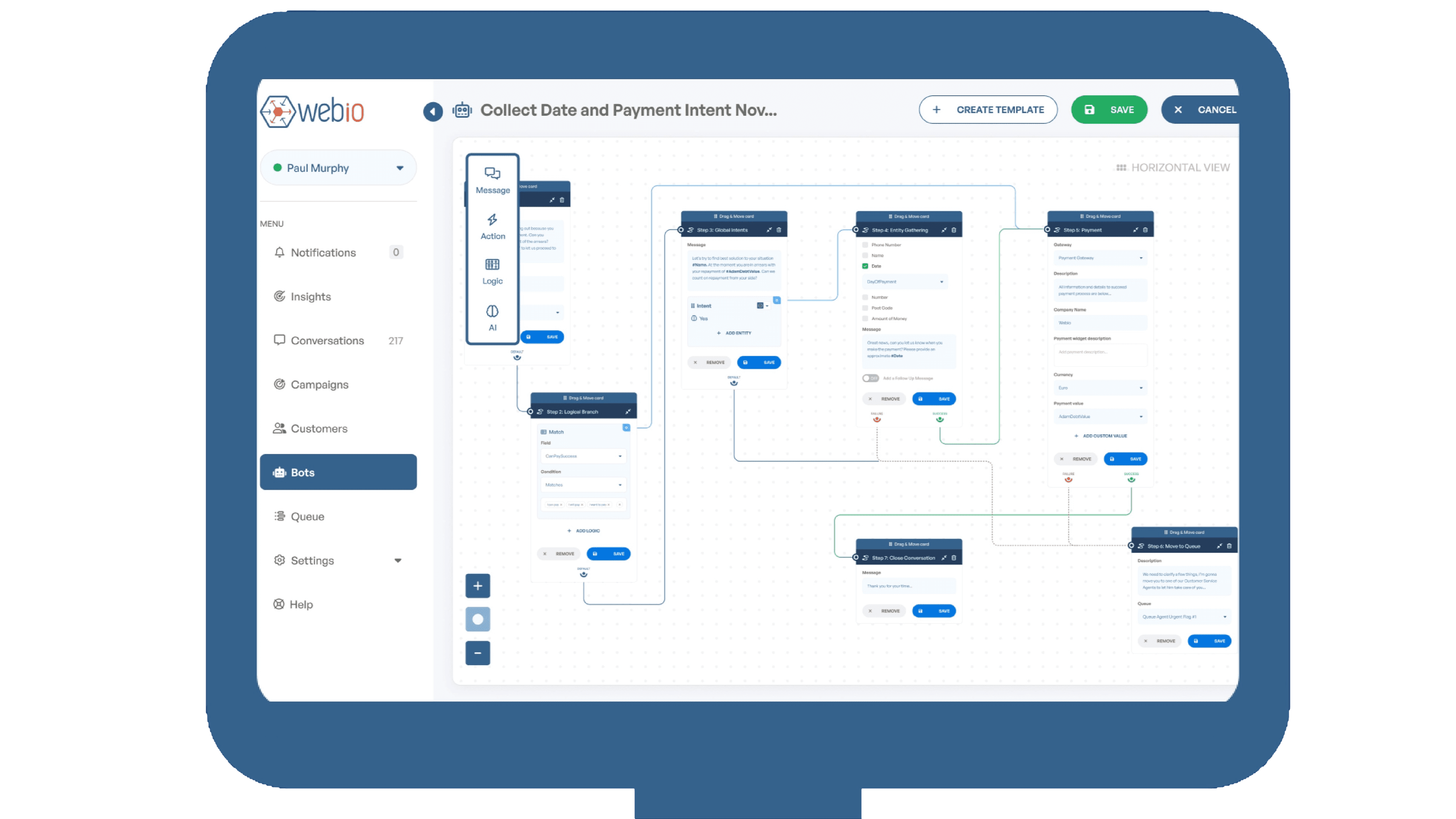
An AI customer engagement platform is software that helps businesses talk with customers more intelligently and at scale.
It combines:
Automation
Personalization
Data analysis
It enables teams to deliver the right message to the right person at the right time.
Core technologies include:
Conversational AI and chatbots
Natural language understanding
Generative AI
Predictive analytics
Machine learning
Omnichannel messaging
Customer data platforms
CRM integration
Behavioral analytics
How AI Connects the Dots Across Customer Touchpoints
Standard tools you will see are virtual assistants for:
Chat and voice
Recommendation engines for product suggestions
Intent detection for routing queries
Sentiment analysis for prioritizing tickets
Campaign automation for messaging
Typical use cases include:
Automating first-line support
Recovering abandoned carts
Improving retention with targeted offers
Delivering tailored product recommendations
Personalizing email and push campaigns to increase conversion
Bringing the Mom and Pop Feeling to Millions
We all grew up in neighborhoods where the mom and pop shop greeted you by name, remembered your favorite snack, and asked about your family. That warm, personal touch made you feel noticed and valued. Wouldn't it be powerful if brands could recreate that feeling for thousands or even millions of customers?
Turning Data into Empathy: How AI Makes Engagement Feel Personal
About 70 percent of global organizations now use AI to boost customer satisfaction, reflecting a clear shift toward AI-powered customer engagement. To produce interactions that feel human and helpful, with the right AI customer engagement platform, brands can mimic that personal care by:
Stitching together customer records
Behavior signals
Real-time context
How AI Agents Change Customer Conversations
Human agents handle nuance, but they cannot work around the clock or scale without expanding staff. AI agents plug those gaps.
When they take over, they:
Field routine questions
Escalate complex issues
Surface the context that human agents need
Agents can run across multiple channels at once, hold conversations in several languages, and keep service consistent.
Designing Goal-Driven Customer Journeys with Agentic AI
When you set a goal, agentic AI can act autonomously to guide prospects through awareness and consideration, provide tailored answers during purchase, and move customers into retention workflows. While keeping the customer experience smooth, these agents also learn from past interactions, improving:
Intent recognition
Reducing handle time
Lowering ticket backlog
How AI Enables Hyper Personalization at Scale
Personalization depends on data, and AI turns data into fast, practical decisions. To create customer segments at the individual level, models analyze:
Browsing patterns
Purchase history
Search terms
Time of day
Device
Even sentiment
That lets you serve product recommendations, customized promos, or content tailored to the customer context in real time. For example, an eCommerce store can suggest the right size after spotting repeated size returns, or push an accessory suggestion at checkout based on past purchases.
Agentic personalization takes this further by:
Making local decisions without human intervention
Choosing when to upsell
When to offer a discount
When to route to an expert
Why AI Chatbots and Virtual Assistants Matter Now
You can shop, move money, and message friends anytime, so customers expect instant support.
AI chatbots and virtual assistants meet that expectation by:
Delivering immediate answers
Processing orders
Completing actions across:
Web
Mobile
SMS
Social channels
They improve response time and consistency, freeing human agents to focus on complex issues that require judgment. Chatbots also reduce operational costs by resolving repetitive requests and improving first contact resolution with knowledge base integration and NLU. Have you tried a conversational shopping agent that suggests products directly on a product page or within search? That same approach increases engagement and boosts conversion.
Predictive Analytics: Seeing What Customers Will Do Next
Predictive analytics looks for patterns that suggest future behavior.
To respond to an offer, it uses:
Purchase cadence
Item affinity
Engagement signals
Churn markers to predict outcomes such as:
Repeat purchases
Likelihood to churn
Propensity
Brands put this to work with:
Timely reengagement messages
Win-back campaigns
Personalized discounts
Inventory prioritization
For example, if a customer shows early signs of churn, predictive models can trigger a retention flow with tailored content or a special offer. Predictive signals also optimize ad spend by focusing acquisition on high lifetime value prospects.
Automation That Frees Teams to Do Better Work
Marketing and support teams spend hours on:
Segmentation
Campaign setup
A/B testing
Reporting
Manual responses
AI automates many of those tasks, from dynamic segmentation and campaign orchestration to creative scoring and subject line optimization.
In eCommerce, automation handles:
Abandoned cart recovery
Personalized email sequences
Retargeting
Bid optimization
That reduces manual load and improves speed to market. Integrations with CRM and CDP systems ensure that automation runs on a single source of truth, so recommendations and messages remain consistent across channels.
Practical Questions to Ask Before You Buy
Which channels do you need to support right away, and which can wait?
How will the platform connect with your CRM and customer data platform?
What level of customization does your team require for dialogue flows and recommendation models?
How do you measure success for customer satisfaction, retention, and revenue lift?
Asking these questions up front helps you match platform capabilities to real business outcomes.
Implementation Steps That Reduce Risk
Start with high-impact use cases like:
Self-service FAQ automation
Abandoned cart flows
Personalized product suggestions
Integrate core data sources early so models have quality inputs. Train intent models on your own transcripts and product catalog to reduce errors.
Run:
Controlled experiments
Measure lift with clear KPIs
Iterate quickly on:
Models
Content
Routing rules
Build human-in-the-loop processes so agents can correct and improve AI behavior in production.
Security, Privacy, and Ethical Guardrails
Handle customer data with strict:
Access controls
Encryption
Clear retention policies
Implement consent management for personalization and analytics, and provide transparent opt-out paths. Monitor for biased model behavior and audit recommendations that affect pricing or eligibility. These steps protect trust and lower regulatory risk for customer-facing AI.
Related Reading
Top 31 AI Customer Engagement Platforms
1. AI Acquisition: How AI Acquisition Helps You Start An AI Business With No Code Or Big Upfront Cash
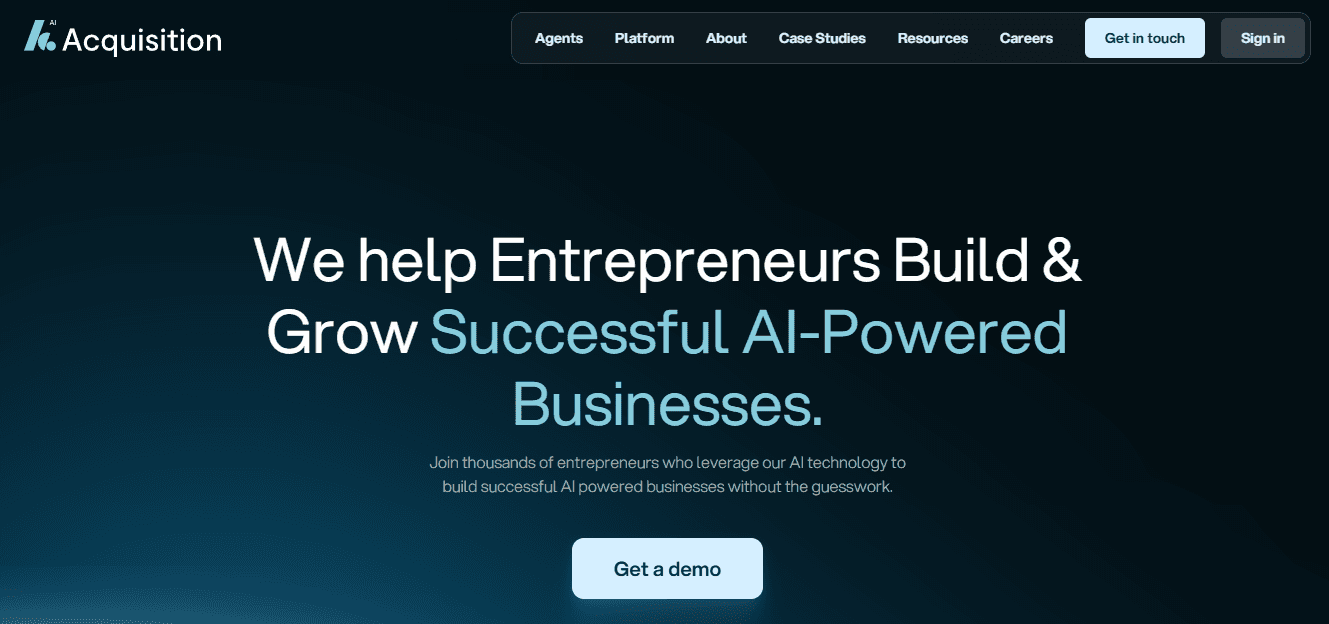
AI Acquisition guides professionals and business owners to start and scale AI-driven businesses using existing AI tools and the proprietary ai-clients.com AI operating system. The approach removes technical barriers and heavy capital requirements so people can build income streams without turning their life into another full-time job.
The System Emphasizes Practical Implementation
You use:
Familiar skills
Automate repetitive work with AI
Grow client relationships
It can be use through predictable processes and client acquisition playbooks. Want to see how someone went from a burned-out corporate director to generating substantial recurring revenue? Check the free training or book an AI strategy call to map your path.
Features
No-code operating system: Use ai-clients.com to run client work without development resources, saving time and cost.
Turnkey client frameworks: Proven templates for outreach, onboarding, and delivery that speed up time to revenue.
AI automation stacks: Automate repetitive tasks so you focus on strategy and client relationships.
Skill to service mapping: Match your existing experience to serviceable AI offers for faster launches.
Scaling playbooks: Step-by-step growth plans to expand clients and revenue predictably.
Strategy consultations: Book a call with a consultant to create a tailor-made plan based on your strengths.
2. Hubspot CRM: Free CRM With Intelligent Lead Scoring And Personalization
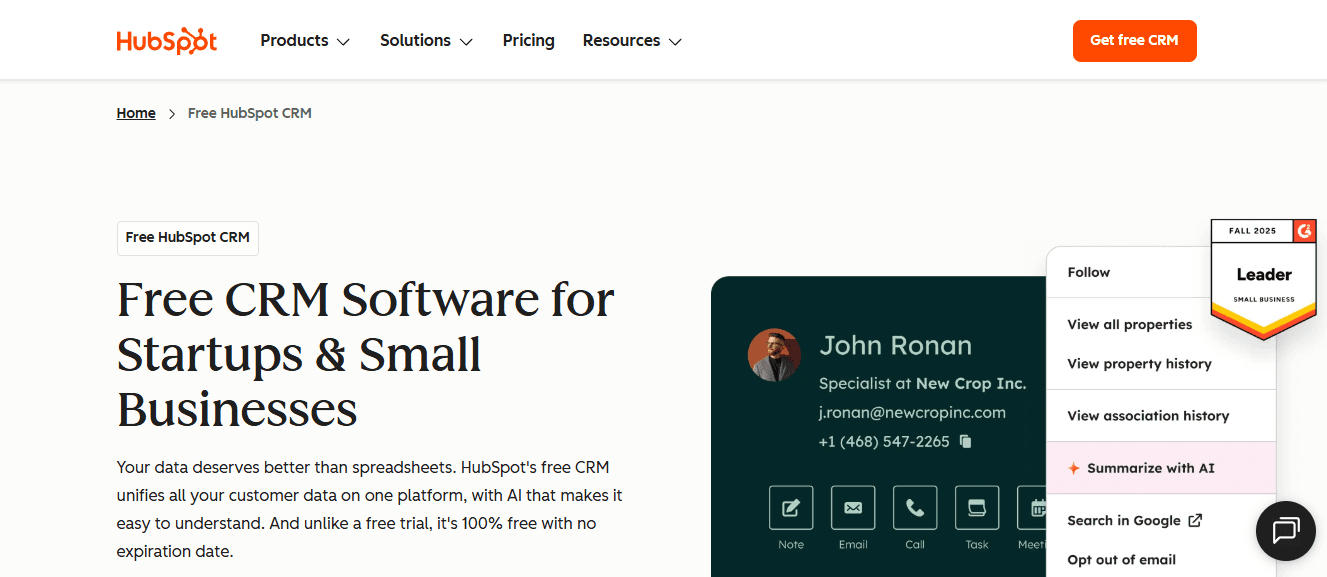
HubSpot CRM organizes contacts and pipelines while adding predictive lead scoring to surface high-potential prospects. The system watches website behavior, email engagement, and other signals to rank leads so sales teams spend time on the right conversations. It also supports dynamic email content and automation that personalizes communications at scale, improving open and click rates through relevance and timing. How would your outreach change if every message felt tailored to the recipient?
Features
Predictive lead scoring: Identifies the highest value prospects so reps focus their effort where it counts.
Behavioral tracking: Monitors page views and engagement to trigger timely follow-up.
Dynamic email content: Personalizes messages for better conversion and engagement.
Free core CRM: Access robust contact and pipeline tools without subscription cost.
Automation workflows: Automate nurturing and routing to reduce manual work.
Reporting dashboards: Visualize lead and deal performance to improve pipeline decisions.
3. Zoho CRM: Sales Automation Plus Omnichannel Customer Service With AI Coaching
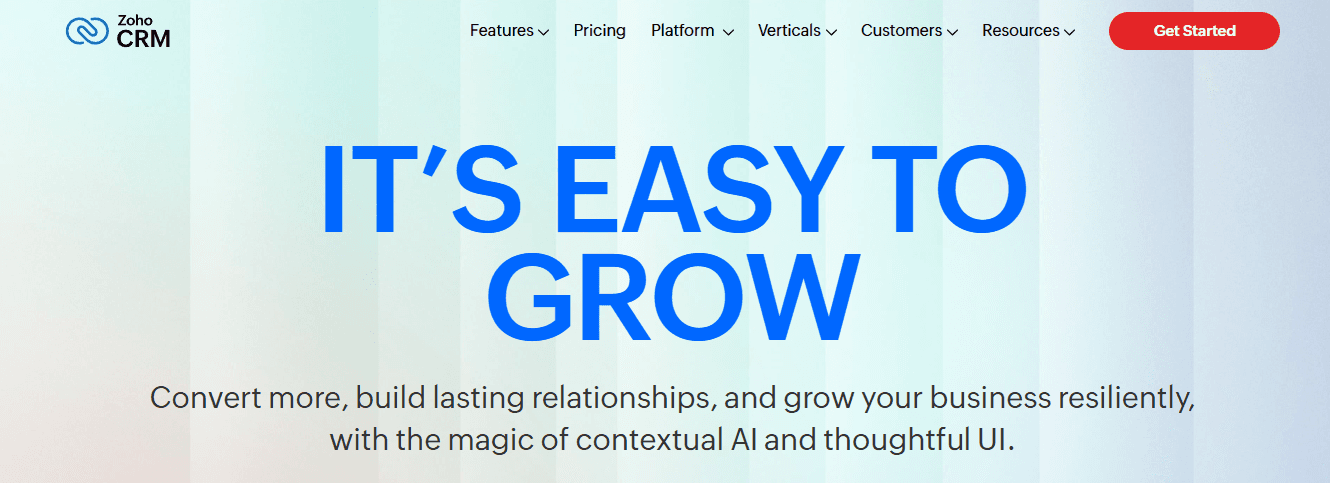
Zoho CRM brings sales automation and an AI assistant, Zia, that:
Suggests leads
Predicts deal outcomes
Coaches reps in the moment
The platform reduces busywork through intelligent workflows that handle:
Data entry
Nurture sequences
Follow-ups
On the service side, Zoho supports intelligent chatbots and sentiment analysis, enabling you to deliver consistent omnichannel support and prioritize issues based on customer emotion. Would your team work differently if the system highlighted high-risk deals and customer pain points before they became crises?
Features
AI sales assistant: Zia recommends leads and actions to increase close rates.
Predictive deal scoring: Forecast deal velocity so you allocate resources more effectively.
Automated workflows: Remove repetitive tasks to keep reps focused on selling.
Omnichannel support: Provide consistent service across chat, email, and social channels.
Sentiment analysis: Detect customer mood to prioritize urgent tickets.
Smart chatbots: Deflect routine queries and capture context for human agents.
4. Zendesk: Fast Customer Support With AI Bots And Self-Service
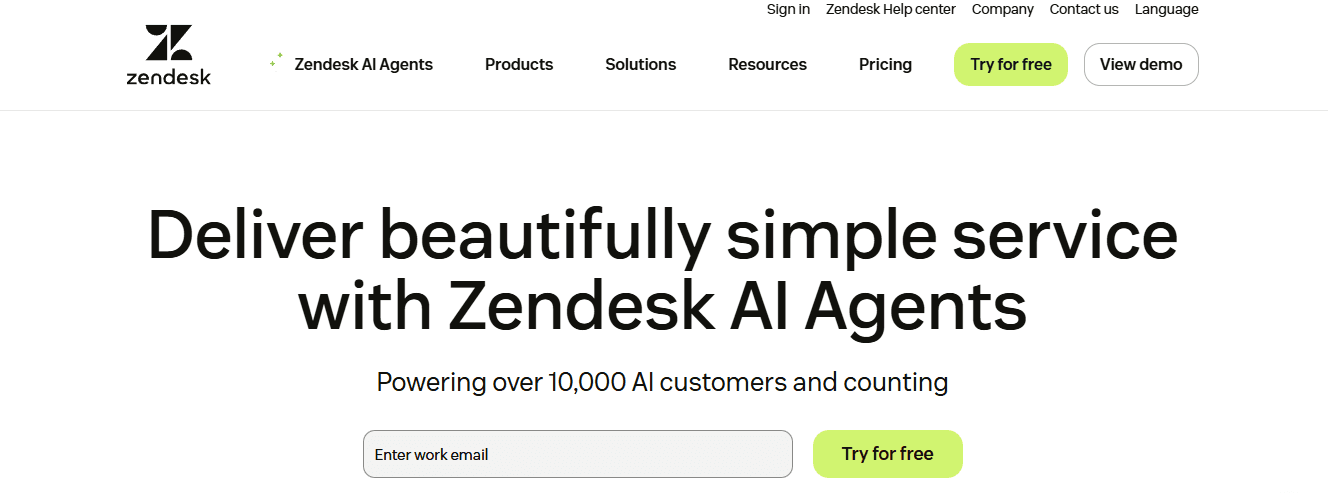
Zendesk equips teams with AI tools like Answer Bot that suggest help center articles and handle common questions to speed resolution. The platform also identifies recurring issues by analyzing conversations, which helps you improve self-service content and reduce ticket volume. Agents receive guidance from AI signals that highlight escalation cases and knowledge gaps, while customers find answers independently through more intelligent search and recommendations. How much support load could you reduce by surfacing the right article at the right time?
Features
Answer Bot: Directs users to relevant help center content to deflect tickets.
Conversation analytics: Finds recurring problems to guide knowledge base updates.
Automated escalation: Moves complex issues to agents with context intact.
Self-service enhancements: Improves search and suggestions for faster answers.
Multi-channel support: Manage email, chat, and social inquiries in one place.
Knowledge base optimization: Use AI insight to refine articles and UX.
5. Freshdesk: Helpdesk Automation That Learns From Interactions
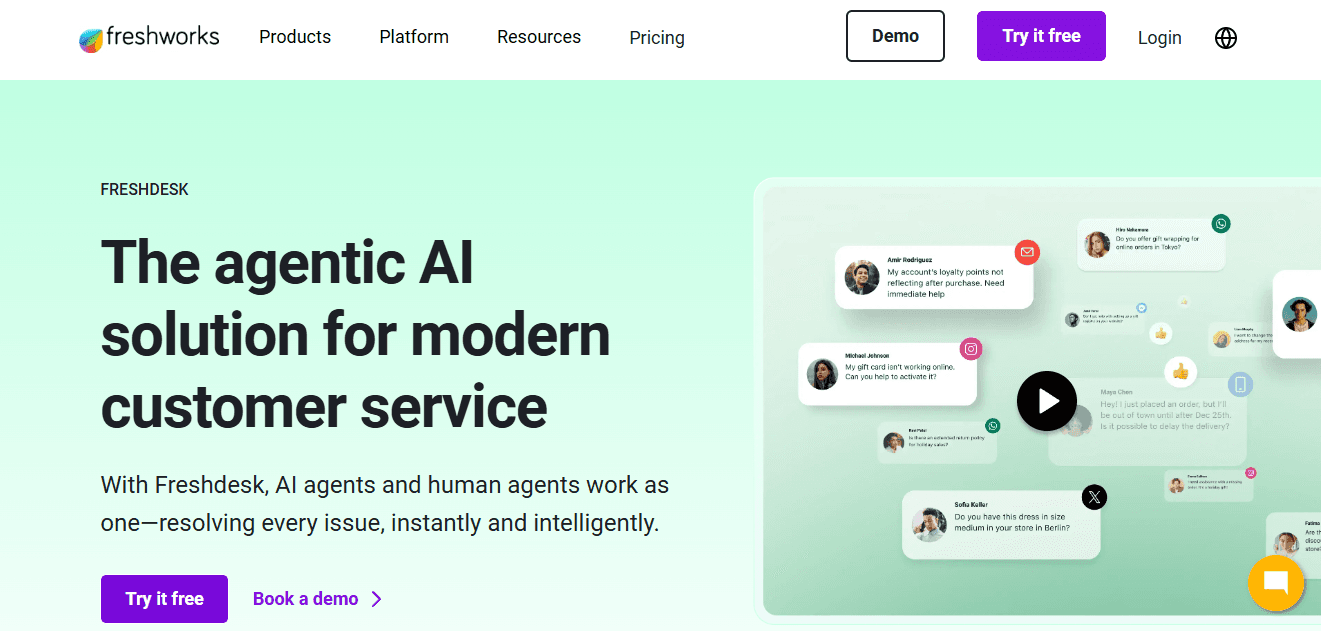
Freshdesk focuses on automating helpdesk workflows, routing tickets, and resolving simple issues through chatbots that learn from past interactions. The assistant assigns the right ticket to the right person and escalates when they detect higher complexity. Customers benefit from enhanced self-service because AI search recommends relevant articles and forum threads based on intent, reducing friction and speeding up resolution. Could your team reclaim hours each week by automating assignment and triage?
Features
Automated ticket routing: Assigns issues to the right agent to cut response time.
AI chatbots: Resolve common problems and collect context before escalation.
Learning search: Suggests knowledge base articles that match user intent.
Priority tagging: Flags urgent or high-value tickets automatically.
Community deflection: Leverages forums to reduce support volume.
Bot to agent handoff: Transfers full context to humans to save time.
6. Drift: Proactive Site Engagement With Intent-Aware Chat

Drift replaces static contact forms with chatbots that start conversations when visitor behavior signals intent. Playbooks trigger targeted messages so prospects get relevant questions and offers at the moment they show interest.
The bot qualifies leads using:
Conversational AI
Captures practical details
Hands off hot prospects to reps
Improving conversion
Shortening sales cycles
What would your conversion rate look like if visitors were engaged before they left the page?
Features
Playbooks: Trigger conversations based on behavior to engage prospects precisely.
Intent detection: Recognizes buying signals to prioritize chats.
Conversational lead qualification: Gathers qualifying data without human effort.
Live agent handoff: Seamlessly moves hot leads to reps for faster closes.
Meeting scheduling: Book appointments directly in chat to speed pipeline flow.
Integrations: Syncs chat data with CRM for unified lead records.
7. Intercom: Unified Messenger For Personalized Conversations
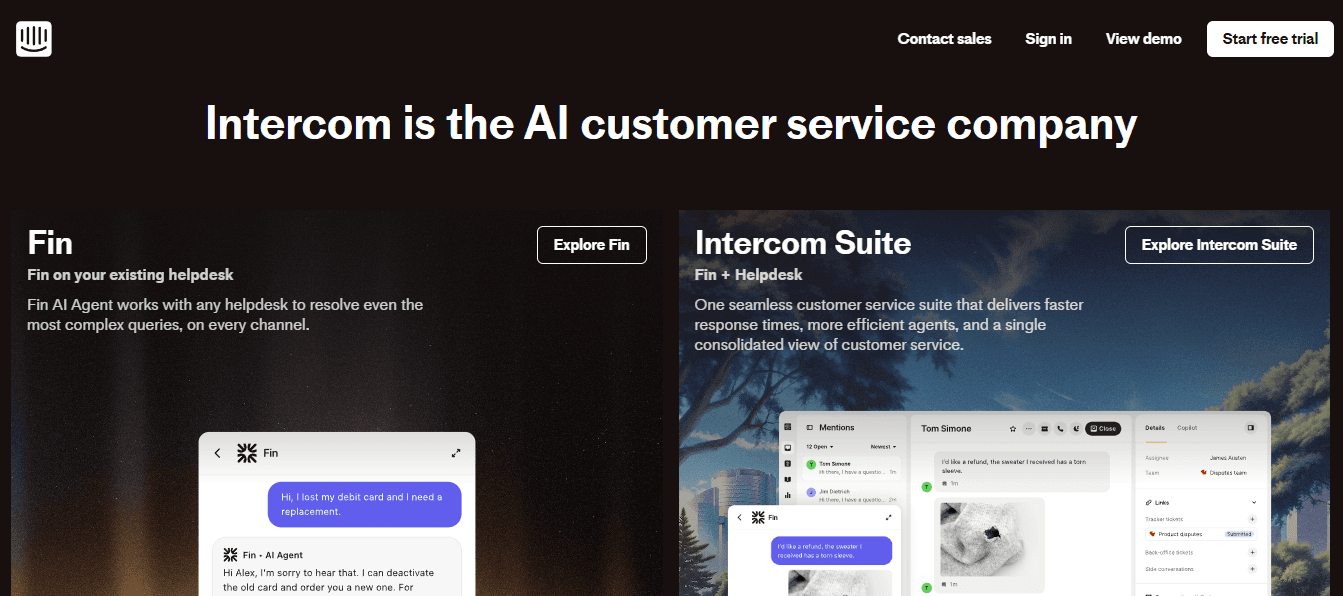
Intercom combines chat, email, and in-app messaging with AI assistants that answer simple questions and route the rest to your team. The platform focuses on conversational engagement and proactive outreach to keep customers progressing through the buyer journey. Intercom’s AI uses sentiment and context to prioritize issues and suggest help articles, so teams respond where they matter most. Have you considered how real-time messaging could reshape onboarding and retention?
Features
Unified messaging: Manage email, chat, and in-app conversations in one view.
AI assistant: Deflects routine queries and surfaces context for agents.
Sentiment prioritization: Flags urgent or negative conversations for quick response.
Proactive messaging: Reach out to users at key moments to boost adoption.
Knowledge suggestions: Recommends help content during conversations.
Audience targeting: Send relevant messages based on behavior and attributes.
8. Document360: Smarter Knowledge Bases With An AI Concierge
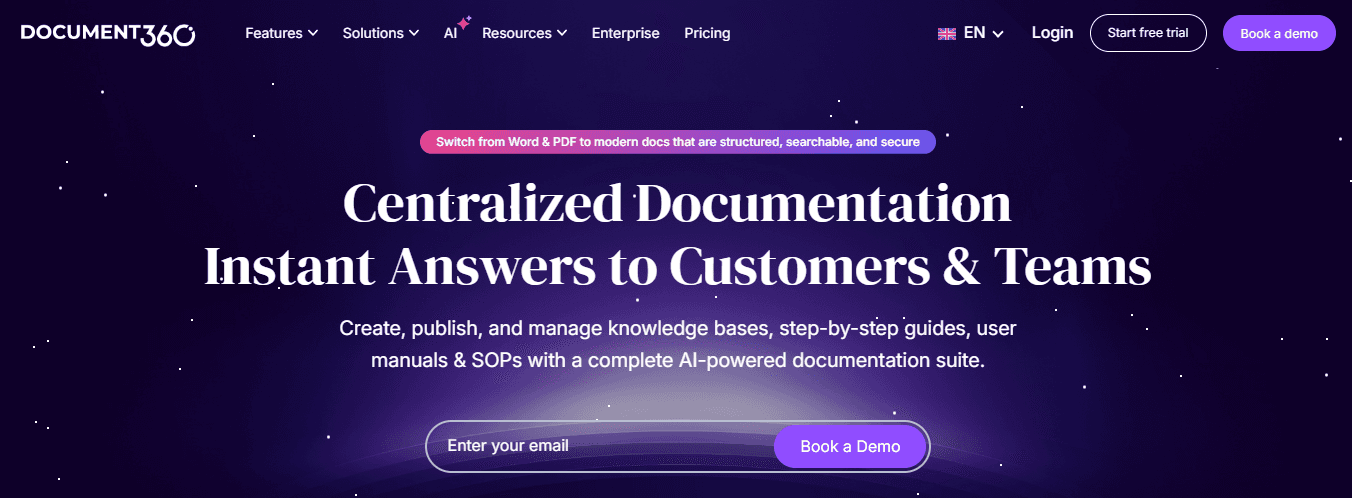
Document360 transforms knowledge management into a search-driven experience with Eddy, an AI assistant that quickly understands intent and finds relevant articles. The platform supports structured categories, version control, and brandable portals so your knowledge looks and works like part of your product. Ask Eddy for content ideas, titles, or SEO meta descriptions and get suggestions that speed content creation and keep information accurate. Could your team save time by letting AI help maintain and surface the proper documentation?
Features
Ask Eddy AI: Conversational search that finds articles based on intent.
Content suggestions: Get titles, meta descriptions, and tag recommendations.
Version history: Track edits and rollback to keep docs accurate.
Custom branding: Create portals that match your company identity.
Flexible taxonomy: Organize content for findability and clarity.
Analytics: See which articles drive self-service and where gaps exist.
9. Tettra: Simple Internal Knowledge With Competent Answers
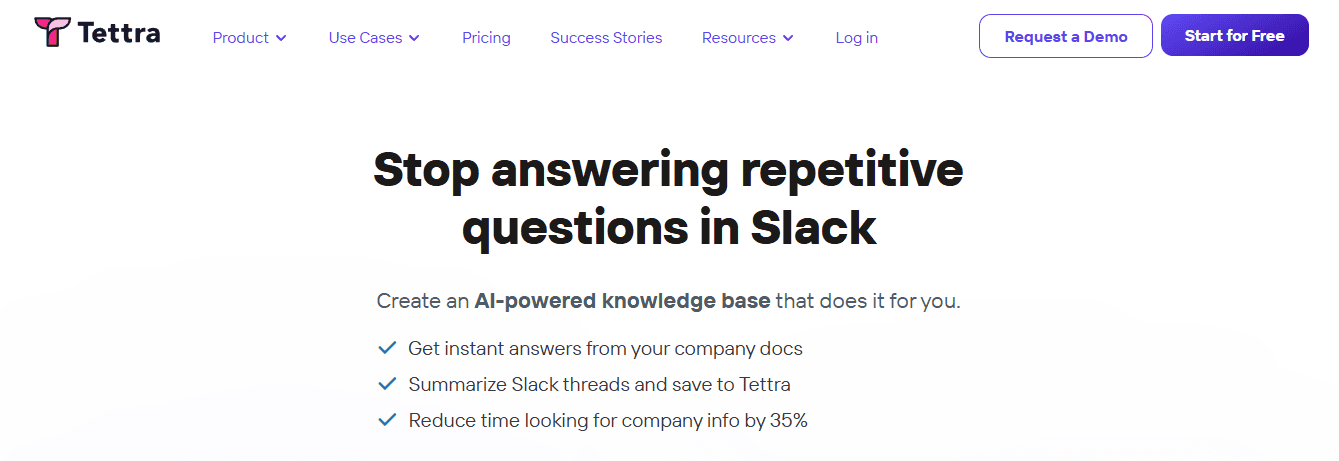
Tettra offers a lightweight knowledge system that helps teams capture and retrieve routine answers in plain language. The AI assistant KAI answers questions and, if needed, converts unknowns into assigned Q A tasks for subject matter experts. Open access makes information discoverable while edit permissions keep content trustworthy, reducing repeated interruptions to experts. Would your team benefit from fewer interruptions and faster internal problem-solving?
Features
Plain language search: Find answers using simple queries.
KAI assistant: Provides instant answers and creates tasks for gaps.
Q&A workflow: Assigns unanswered questions to experts and tracks resolution.
Permission control: Ensure only appropriate users can edit content.
Page editor: Easy content creation so everyone can contribute.
Integration plugs: Connects with Slack and other tools to surface answers where work happens.
10. Involve.Me: Interactive Feedback And Ai Insights Without Coding
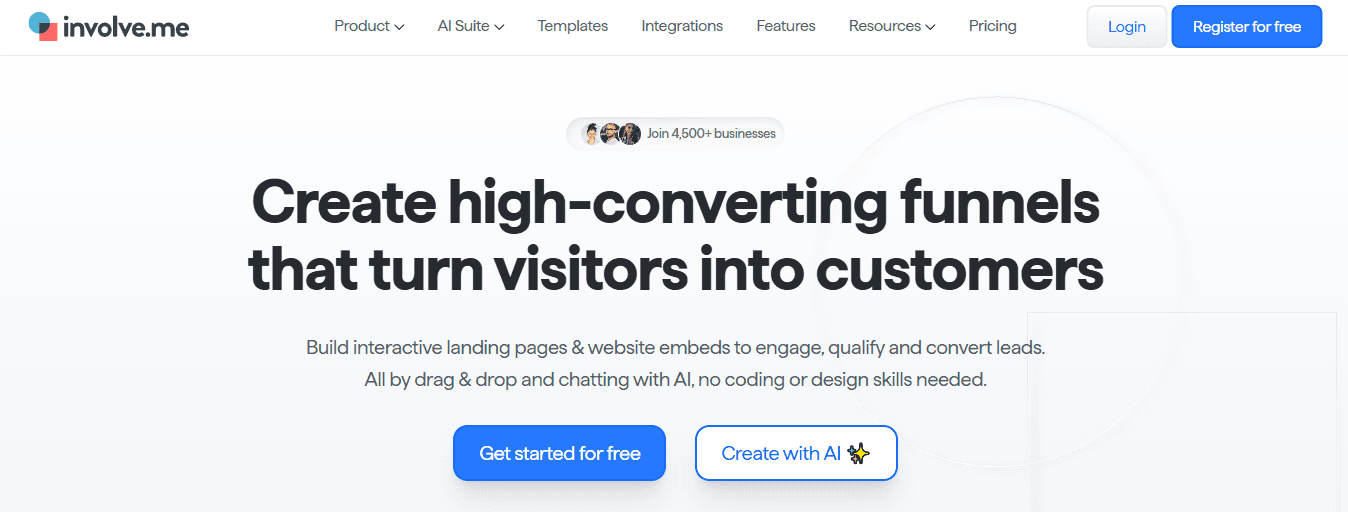
involve.me helps you build interactive surveys, quizzes, and forms that feel personal and engaging without developer support. The platform uses AI to analyze responses, surfacing trends and sentiment so you can act on feedback faster. You can distribute surveys across channels and use AI-generated reports to convert raw responses into clear next steps. How would better feedback change product decisions or marketing messages this quarter?
Features
Drag and drop builder: Create engaging surveys and quizzes with no code.
AI insights: Automatically generate reports and identify trends.
Multi-channel distribution: Send forms via email, web, and social.
Conditional logic: Personalize questions based on answers for richer data.
Templates: Use prebuilt survey flows to save time.
Response segmentation: Filter answers to identify key audience groups.
11. Surveysensum: Nps And Csat Focused Feedback With Sentiment AI

SurveySensum is built for customer success teams that track NPS, CSAT, and CES across touch points to reduce churn. Its AI features include sentiment analysis and churn signals so teams can take proactive retention steps. Automated workflows route feedback to the right owner and create playbooks for outreach to unhappy customers. Would proactive alerts change how quickly you intervene with at-risk accounts?
Features
NPS and CSAT templates: Measure loyalty and satisfaction across the journey.
Sentiment analysis: Detect emotion in open responses to prioritize follow-up.
Churn prediction: Identify accounts at risk so you can act earlier.
Automated routing: Send responses to owners with context and suggested actions.
Touch point mapping: Collect feedback at key moments across the lifecycle.
CX dashboards: Visualize trends to inform product and success strategies.
12. Mailchimp: Email Marketing That Grows With You

Mailchimp makes email marketing approachable with a drag-and-drop builder and templates for beginners and experienced marketers alike. The platform adds automation, segmentation, and behavioral triggers so messages reach the right people at the right time. With eCommerce integrations and analytics, you can track campaign ROI and optimize offers based on customer activity. What small change could increase your open rates next month?
Features
Drag and drop editor: Build polished emails without design skills.
Behavioral automation: Trigger messages based on site or purchase actions.
Segmentation tools: Target audiences by interests and behavior for relevance.
Template library: Use or customize designs to match your brand.
eCommerce integration: Sync products and track revenue from campaigns.
Performance analytics: Measure opens, clicks, and conversions to improve results.
13. Benchmark Email: Affordable Marketing With Dynamic Personalization
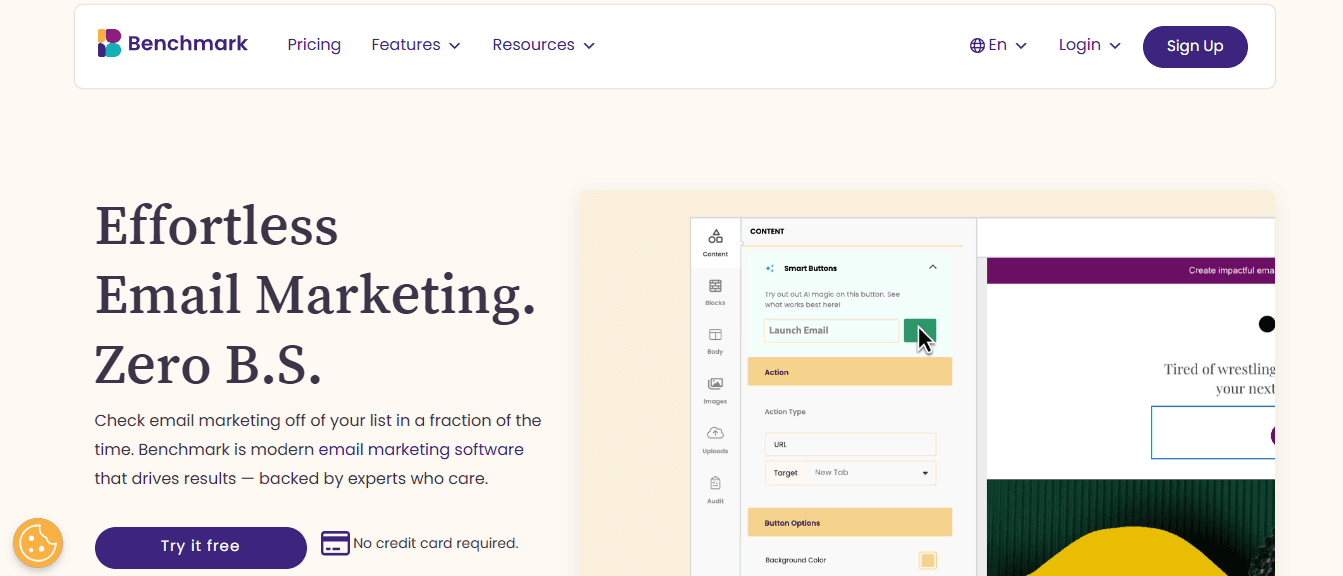
Benchmark Email offers simple campaign creation with AI features like Smart Content that personalizes messages at scale. The Smart Send feature improves deliverability by removing unengaged addresses and focusing on active recipients. Integrations with eCommerce systems and list-building tools help businesses showcase products and grow audiences efficiently. Could improved deliverability result in better campaign ROI for your offers?
Features
AI Smart Content: Personalizes email copy for higher engagement.
Smart Send: Boosts deliverability by excluding unengaged contacts.
List building tools: Create forms, pop-ups, and landing pages to capture leads.
eCommerce blocks: Showcase products easily within campaigns.
Affordable tiers: Cost-effective plans for small teams and startups.
Analytics: Track campaign performance and subscriber behavior.
14. Buffer: Grow Social Reach Without Paid Ads
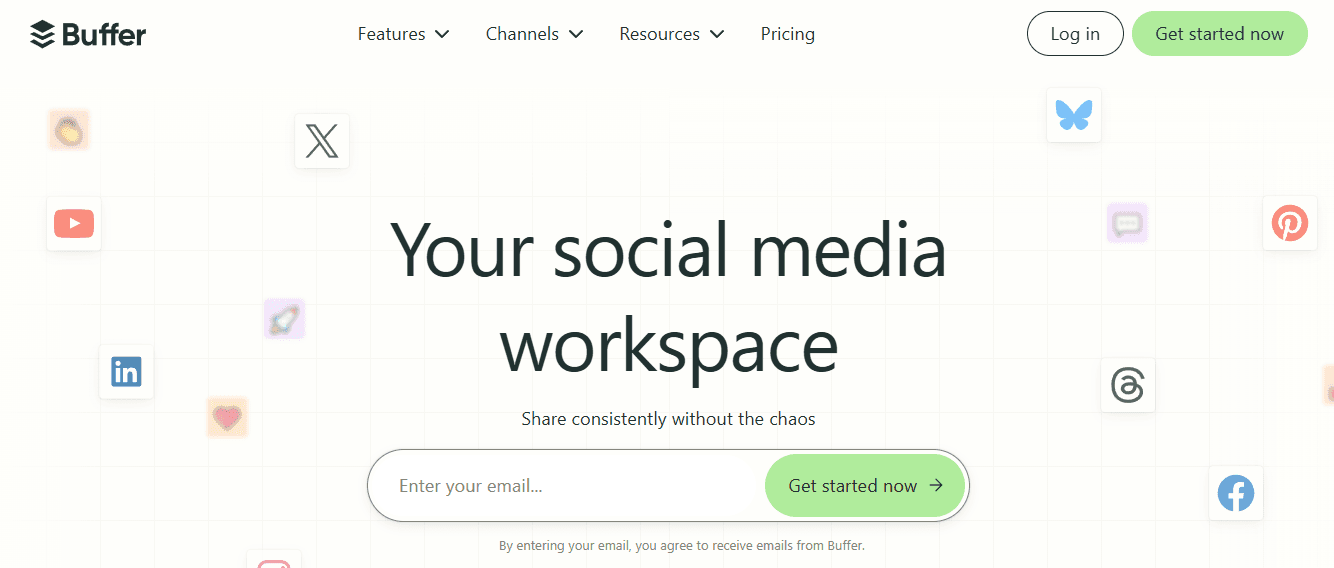
Buffer helps small teams schedule posts, collaborate, and analyze social performance across channels. AI suggestions surface your best posts and recommend hashtags and post timing to improve organic reach over time. The platform focuses on consistent content delivery and precise analytics so you can learn what resonates without guesswork. Which post performed better last month and why?
Features
Post scheduling: Plan content to maintain a consistent presence.
AI content suggestions: Recommend hashtags and best times to post.
Performance analytics: Identify top-performing posts and trends.
Team collaboration: Approve drafts and coordinate publishing with ease.
Multi-network support: Manage major platforms from one dashboard.
Content calendar: Visualize and organize your social plan.
15. Socialbee: Social Media Co-Pilot For Steady Posting
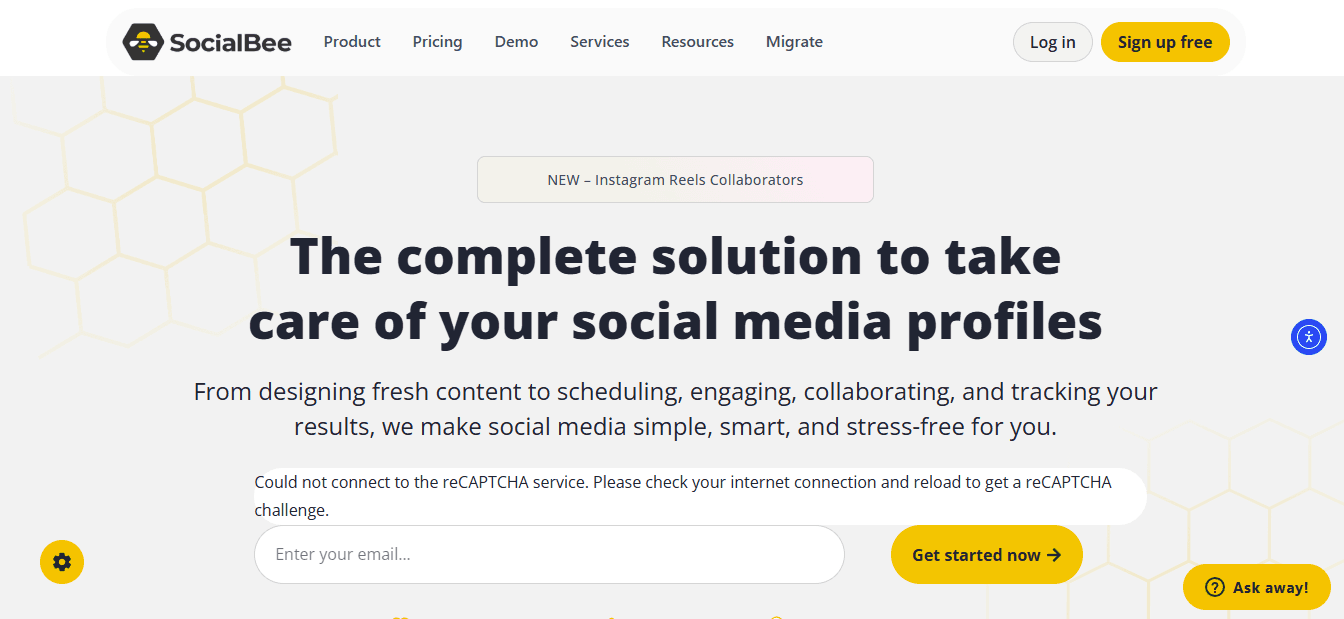
SocialBee offers content automation and a robust AI Copilot to generate post ideas and keep feeds populated with relevant content. It combines category-based scheduling and post-recycling to maintain a steady presence without daily effort. The AI post generator tailors language and tone to your audience, helping you grow consistent engagement. How would a reliable content stream change your audience growth plans?
Features
AI Copilot: Drafts posts and suggests content tailored to your audience.
Category scheduling: Automatically maintain a balanced mix of content types.
Post recycling: Reuse high-performing content to maximize reach.
Integrated content creation: Produce captions and images in one flow.
Collaboration tools: Coordinate approvals and feedback among team members.
Analytics: Measure engagement and refine content strategy.
16. Gainsight: Enterprise Customer Success For Retention And Growth
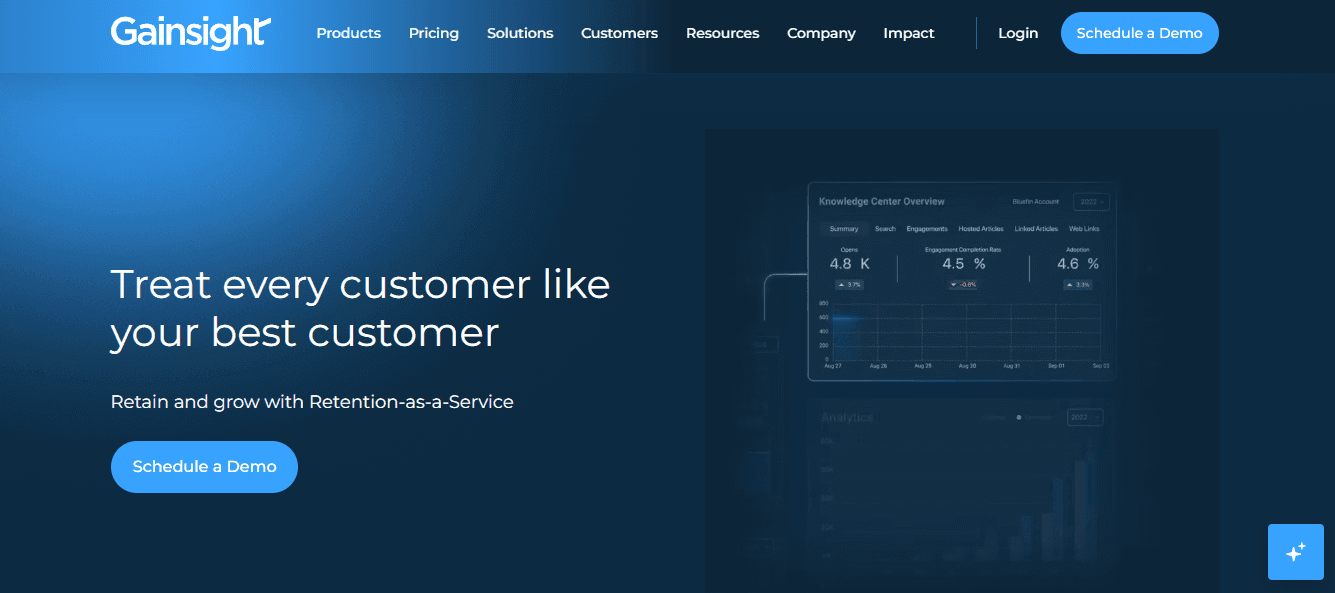
Gainsight provides an enterprise-grade customer success platform focused on retention and expansion through customer health scoring and playbooks. The system aggregates product, support, and usage data to give teams a single view of account health. Customer success managers get alerts, recommendations, and automated tasks that help them prevent churn and find upsell opportunities. What would happen to revenue if you reduced churn by a few percentage points?
Features
Customer health scoring: Combine signals to prioritize accounts for action.
Automated playbooks: Trigger outreach sequences based on account conditions.
360-degree data view: Consolidate CRM, usage, and support signals for clearer decisions.
Journey orchestration: Manage onboarding and renewal flows with automation.
Executive reporting: Share retention metrics and forecast impact with leadership.
Expansion planning: Identify opportunities for cross-sell and upsell.
17. Churnzero: Predict Churn And Automate Retention
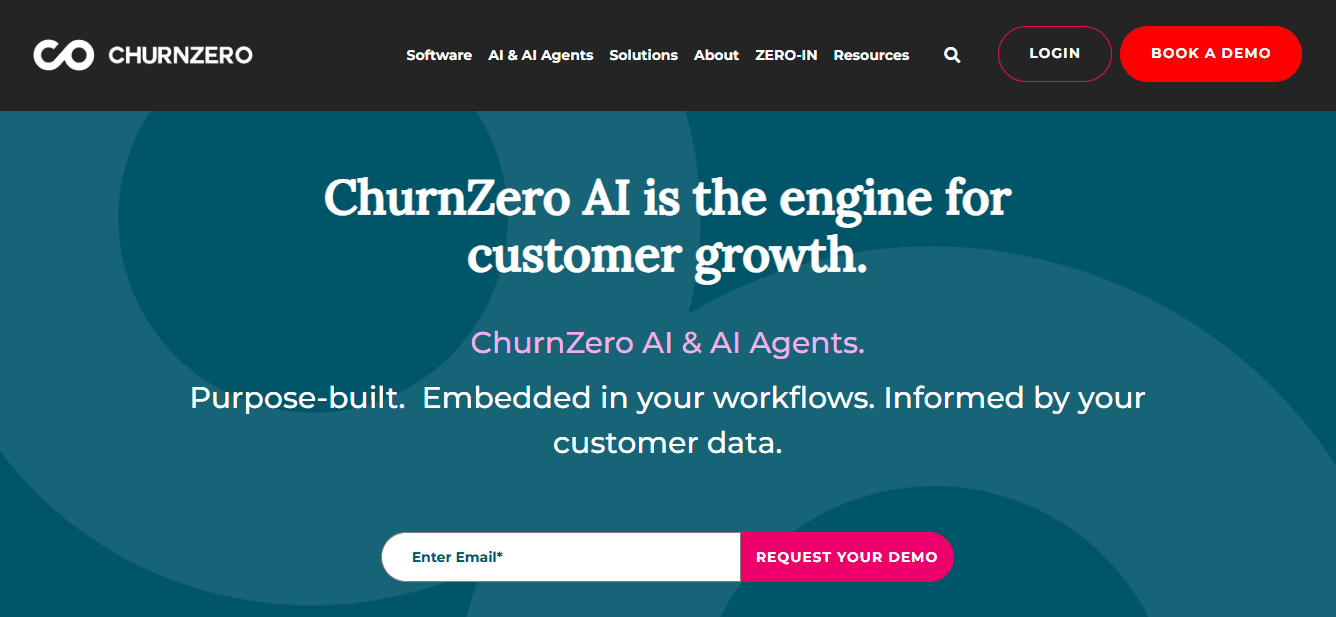
ChurnZero focuses on predicting churn and automating retention campaigns with customer health and playbooks.
To surface accounts that need attention, the platform tracks:
Product usage
Engagement
Sentiment
Automated outreach and in-product nudges help keep customers engaged and reduce revenue leakage. When did you last examine the accounts most likely to churn this quarter?
Features
Churn prediction: Identify at-risk customers to focus retention efforts.
Health scores: Segment customers by engagement and risk level.
Automated campaigns: Trigger lifecycle emails and nudges to re-engage users.
Usage insights: Understand feature adoption to guide success plans.
Account playbooks: Standardize responses to standard churn signals.
Integration support: Connect product telemetry and CRM for richer signals.
18. Userpilot: Personalize Onboarding With Contextual Guidance
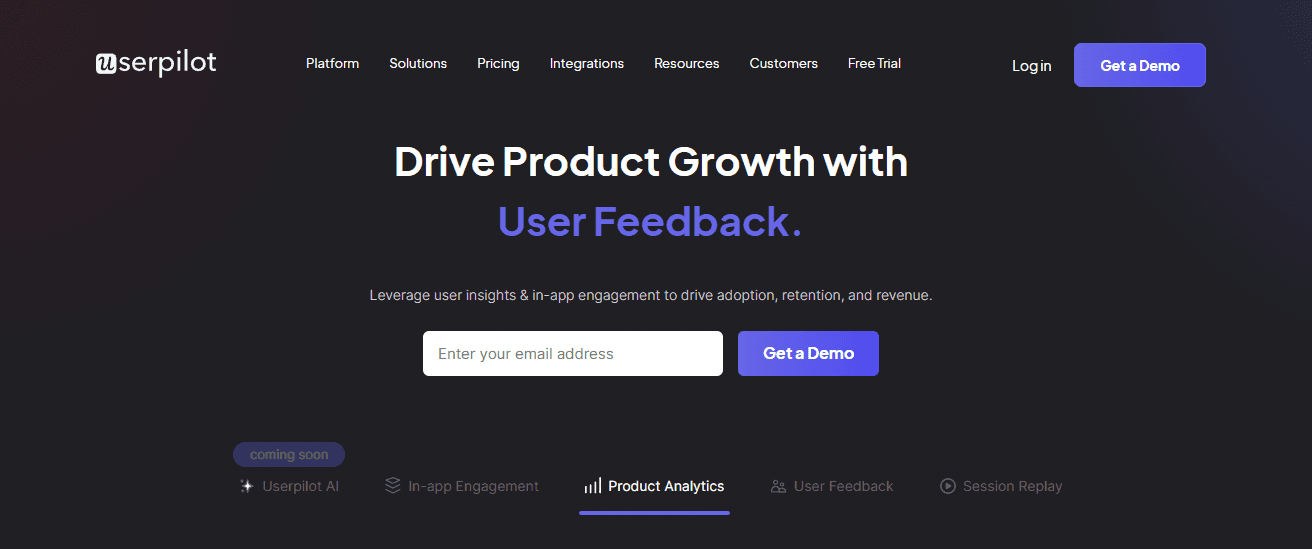
Userpilot personalizes user onboarding and product tours based on in-app behavior to accelerate activation. The tool lets you show contextual messages and flows that guide users to meaningful actions at the right time. This increases feature adoption and reduces time to value by meeting users where they are in the product. Which onboarding steps could convert more trial users into paying customers?
Features
Behavioral triggers: Show tours and messages based on user actions.
In app flows: Create contextual guidance without engineering help.
Segmentation: Target onboarding by persona or usage pattern.
A/B testing: Compare onboarding variations to optimize conversion.
Product analytics: Track how users interact with features during onboarding.
No code editor: Build experiences quickly without developer time.
19. Whatfix: In-App Help That Guides Users Where They Work
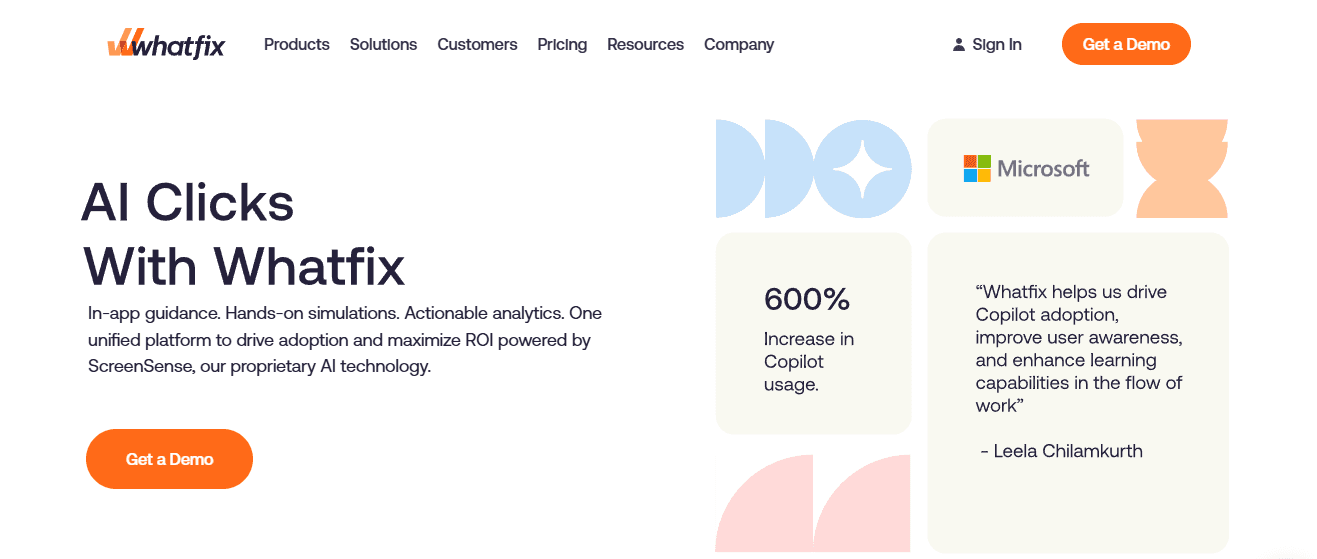
Whatfix delivers in-app guidance, walkthroughs, and microlearning to reduce support volume and improve adoption. The platform provides contextual assistance tied to specific tasks so users learn by doing. Digital adoption analytics show you where users struggle so you can refine content or product flows for better outcomes. What task do most users need help with right now?
Features
Task-based walkthroughs: Guide users step by step inside the app.
Smart search: Surface relevant help articles within context.
Microlearning modules: Deliver short lessons to reinforce behavior.
Adoption analytics: See where users drop off to prioritize fixes.
Content personalization: Tailor guidance by role and experience level.
Multilingual support: Offer guidance across languages for global teams.
20. Mixpanel: Product Analytics That Predict Behavior
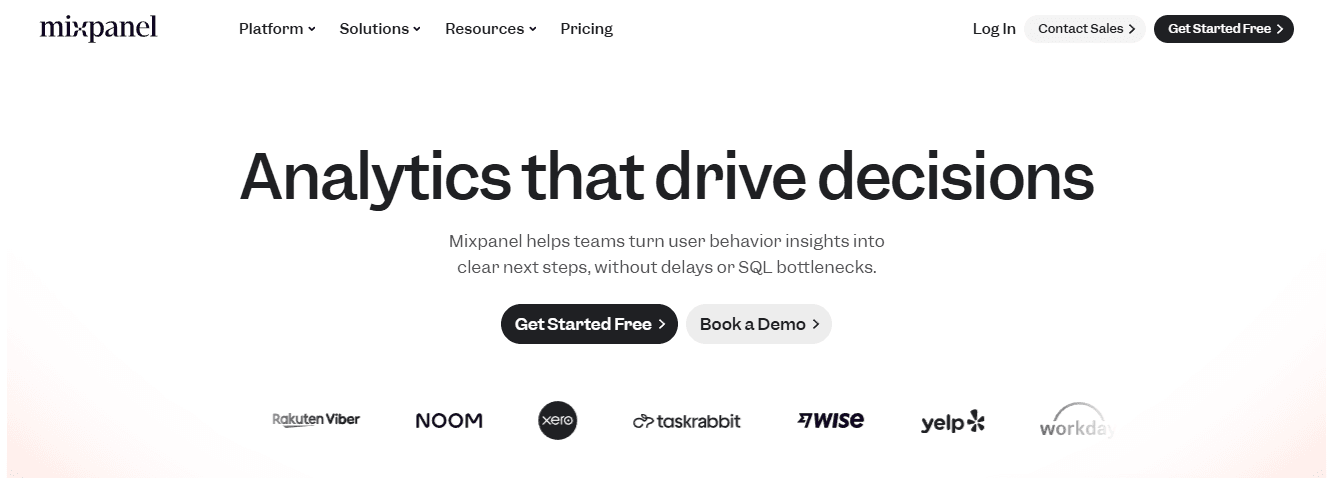
Mixpanel gives product and growth teams an event-based view of user behavior, enabling cohort analysis and predictive insights. The AI surfaces patterns and flags anomalies so teams can react to retention or engagement shifts quickly. You can use Mixpanel to identify which features drive retention and to test product changes with confidence. Which metric would move your business forward fastest if you improved it?
Features
Event tracking: Measure actions users take to understand behavior.
Cohort analysis: Compare groups to see long-term retention impact.
Predictive insights: Forecast likely future behavior from signals.
Anomaly detection: Alert you to sudden changes in user activity.
Funnel analysis: Find where users drop off and optimize flows.
Experiment tracking: Measure the impact of product changes on outcomes.
21. Google Analytics: Web And App Analytics With Predictive Features
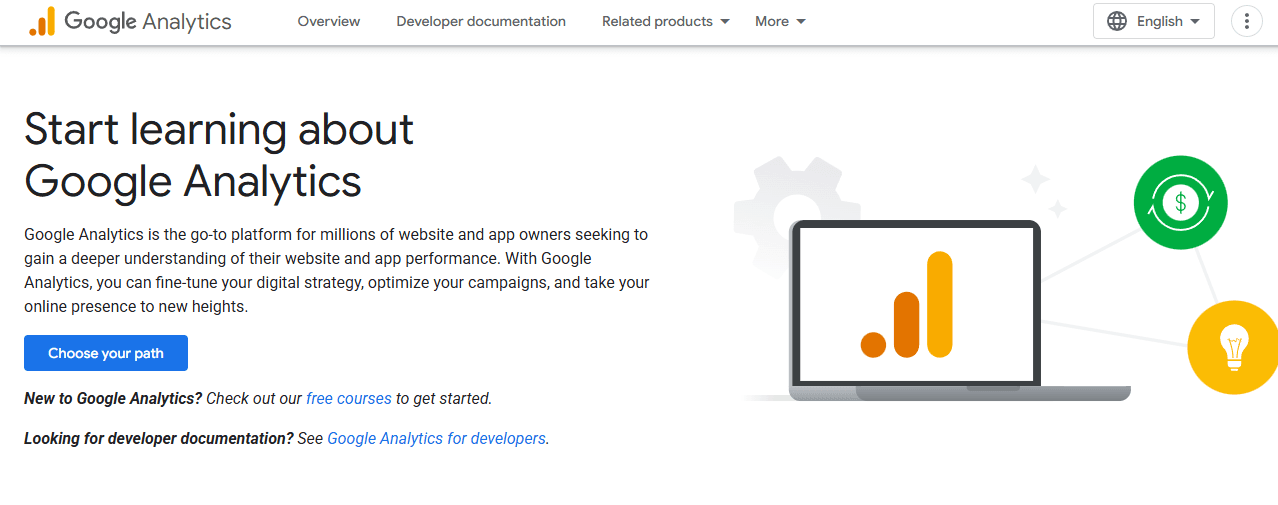
Google Analytics measures traffic, engagement, and conversions across sites and apps while offering machine learning driven insights. The platform helps you identify how channels perform, which pages convert, and where to improve customer journeys. Predictive metrics can indicate likely purchasers or users at risk, so you can adapt campaigns and messaging in response. What signal would you act on first if you could spot at-risk users earlier?
Features
Traffic and behavior reports: See how users navigate your site and product.
Conversion tracking: Measure funnel performance and attribution.
Predictive audiences: Identify likely converters for targeted campaigns.
Cross-device analysis: Understand user journeys across web and mobile.
Custom dashboards: Share insights with stakeholders quickly.
Integrations: Connect with advertising and analytics tools for richer insights.
22. Questera: AI Agents That Act Like Expert Teammates
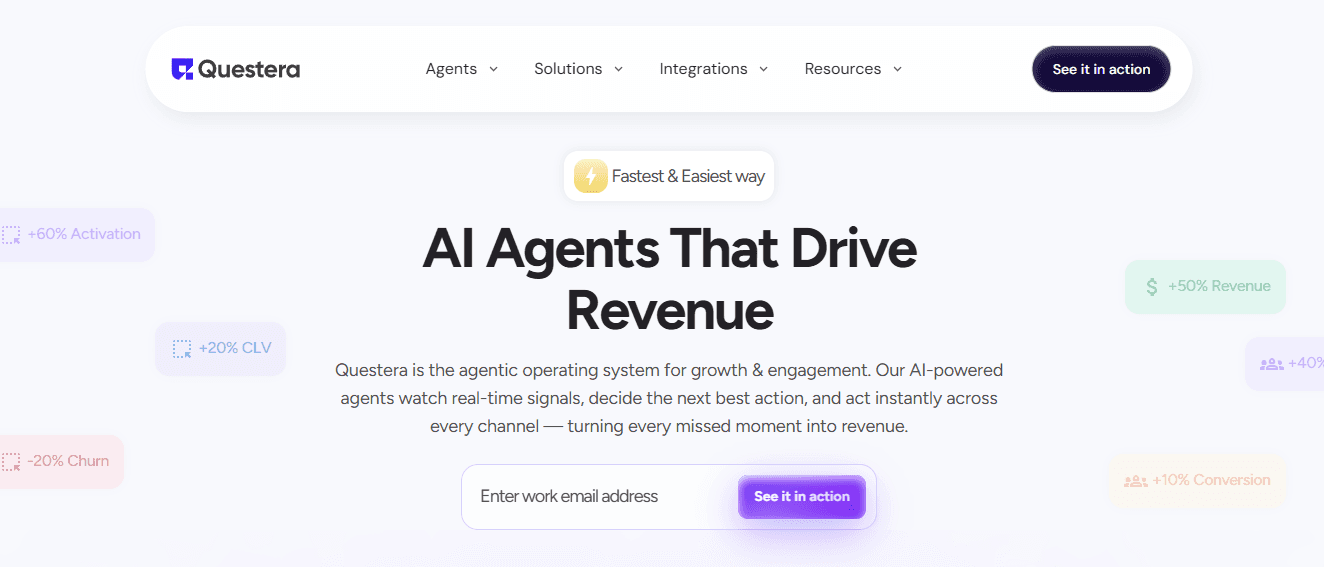
Questera provides a network of specialized AI agents designed to manage daily tasks and execute campaigns in real time. The agents operate like virtual colleagues, optimizing workflows and timing client communications for maximum impact. This approach frees human time by automating execution while keeping control over strategy and creative direction. What tasks would you want a reliable virtual teammate to handle every day?
Features
Fast campaign execution: Launch targeted campaigns quickly to get immediate results.
Cost-efficient operations: Use AI-driven processes to boost return on ad spend and labor efficiency.
Automated workflows: Resolve routine tasks with AI agents so teams focus on higher value work.
Data-driven activators: Use insights to personalize outreach and improve engagement.
Seamless integrations: Connect Questera to existing tools for unified operations.
Real-time optimization: Adjust campaigns as signals change to improve outcomes.
23. Braze: Real-Time, Cross-Channel Engagement With AI Recommendations
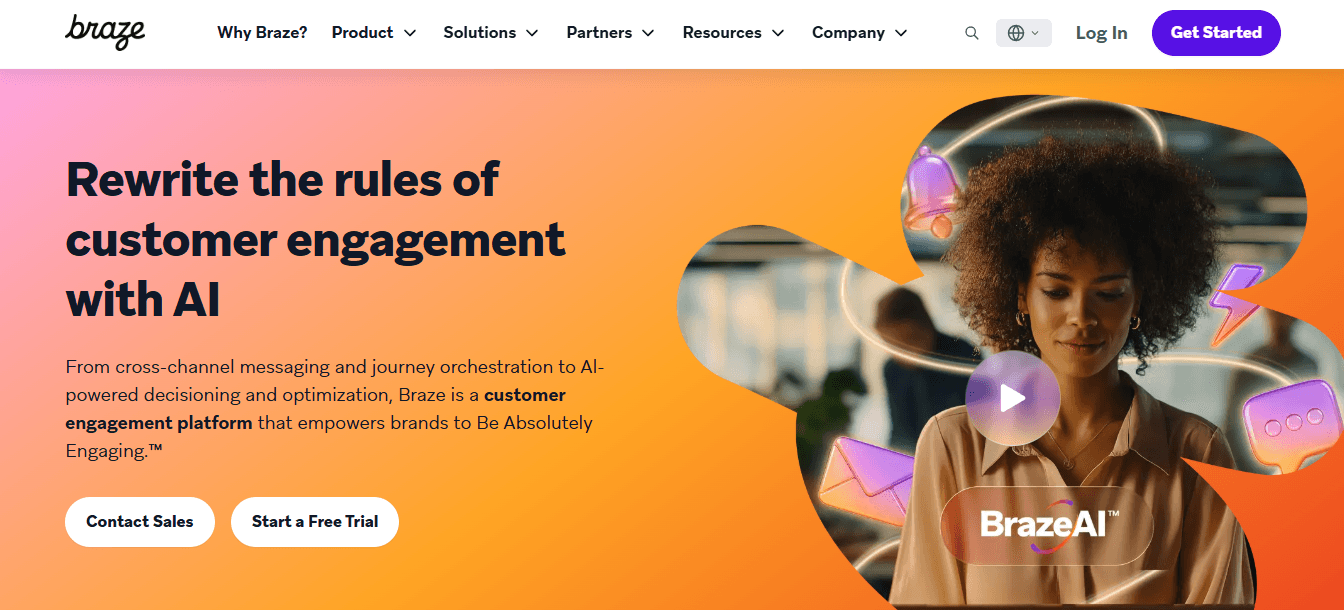
Braze orchestrates customer journeys across email, push, SMS, and in-app messaging with AI that recommends timing and content. The platform focuses on delivering relevant messages at scale, using behavioral data to shape experiences. BrazeAI learns from performance to suggest optimizations that increase conversions and retention. How would your conversion rates change if every touch felt personally timed?
Features
Journey orchestration: Automate cross-channel customer paths for consistency.
Cross-channel messaging: Reach customers on the channels they use most.
Real-time execution: Send messages instantly as events occur.
AI-powered growth: Get content and timing suggestions based on data.
Scalability: Run campaigns from small tests to global programs.
Security and compliance: Keep customer data protected while scaling.
24. Salesforce Cloud: CRM And Cloud Tools That Unify Customer Data
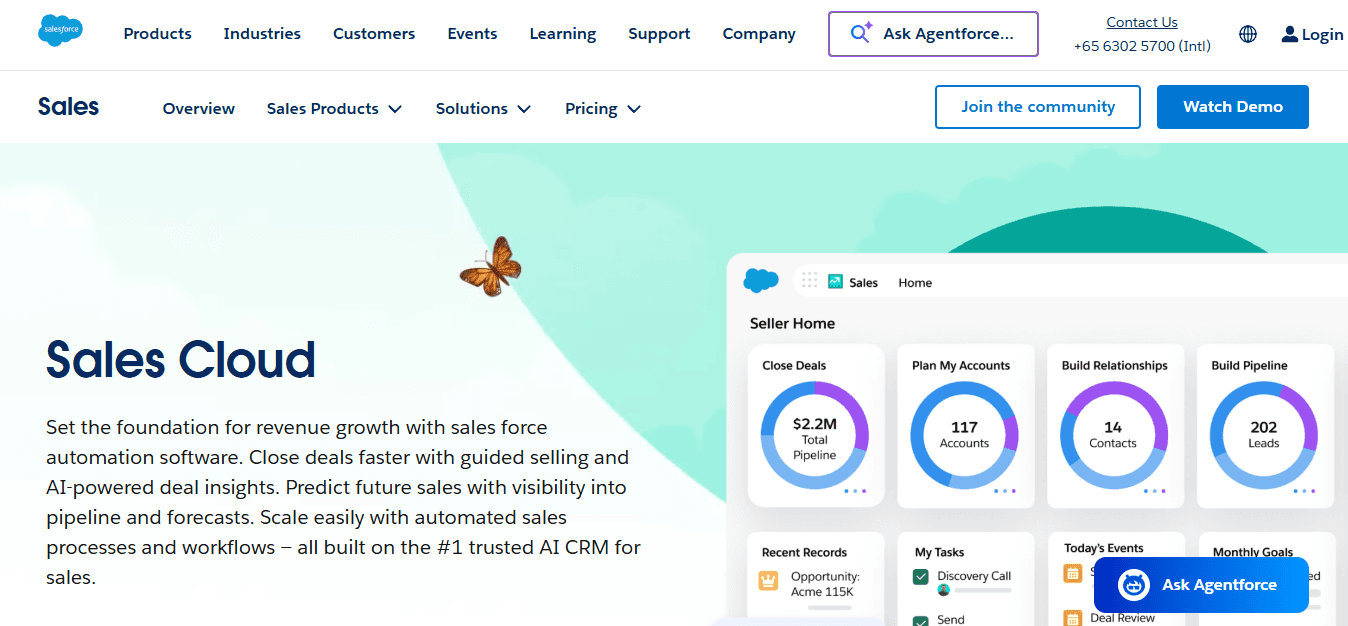
Salesforce Cloud collects customer data across sales, service, and marketing to create unified profiles that drive personalized engagement. AI features analyze behavior and recommend the best actions so teams can be more effective in every interaction. A shared data model lets teams coordinate timing, messaging, and support with a single source of truth. Which process would get easier if everyone used the same customer record in real time?
Features
Unified customer data: Centralize interactions for consistent personalization.
Seamless integration: Connect sales, marketing, and service workflows.
AI-driven insights: Surface recommendations and forecasts based on data.
Real-time visibility: Monitor customer interactions across touch points.
Custom workflows: Automate processes tailored to your business.
Enterprise scale: Support global teams with robust compliance and controls.
25. MoEngage: Personalization Engine For Multi-Channel Engagement
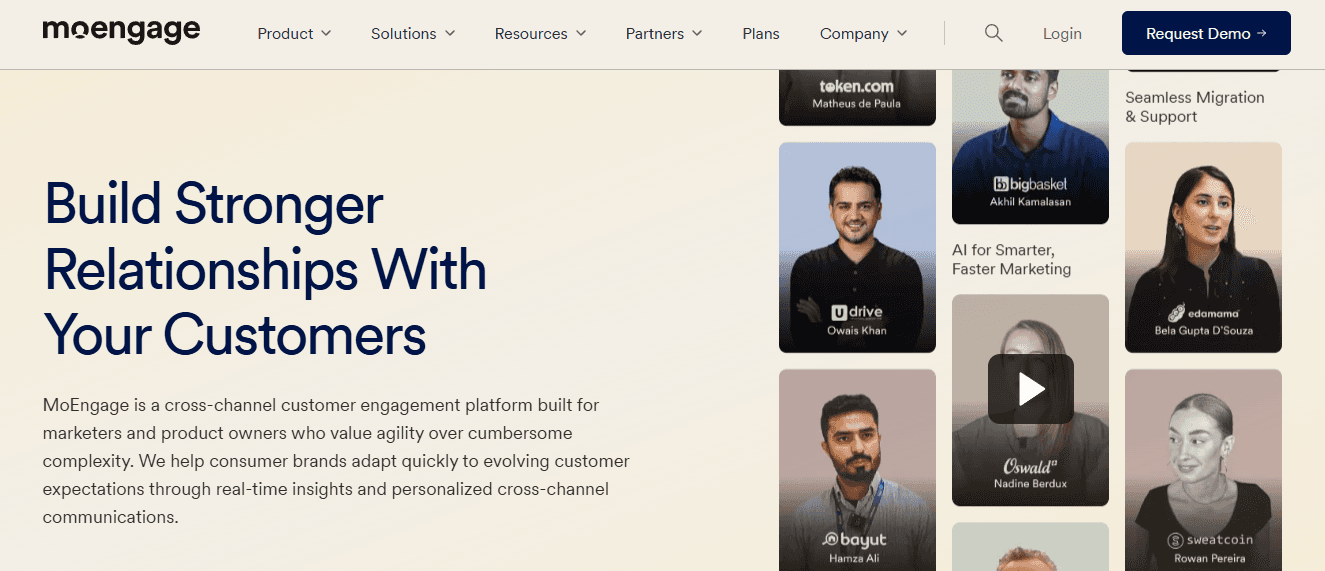
MoEngage enables personalized campaigns across mobile, web, email, and push using real-time segmentation and predictive models. The platform helps brands deliver context-specific messages to boost engagement and conversions. Predictive engagement features anticipate behavior so you deliver the right message at the right time. What would personalized messaging at scale do for your retention metrics?
Features
Real-time segmentation: Target audiences instantly based on actions and attributes.
Personalized messaging: Tailor content to individual preferences for higher conversion.
Automated campaigns: Orchestrate multi-channel journeys with minimal manual work.
Insights and analytics: Track campaign effects and user trends to refine strategy.
Predictive engagement: Use AI to forecast user behavior and optimize timing.
Cross-channel orchestration: Coordinate messages across devices for seamless experiences.
26. Customer.io: Data-Driven Messaging Across Many Channels
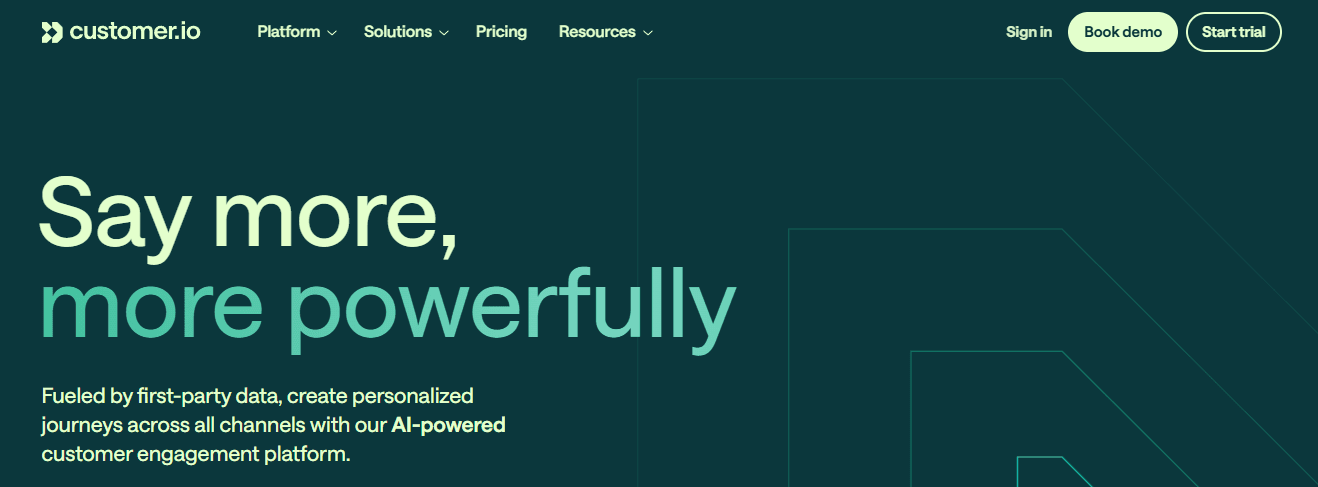
Customer.io helps teams send behaviorally triggered messages across email, SMS, push, and in-app channels using data-driven segmentation. The platform makes it easy to automate lifecycle campaigns so customers receive relevant communications at scale. Integrations let you pull in event data and personalize outreach, improving conversion across onboarding, retention, and re-engagement. Which lifecycle stage could use more automation in your funnel?
Features
Real-time segmentation: Target users based on live behavior and attributes.
Omnichannel support: Manage email, SMS, push, and in-app from one place.
Automated journeys: Build and scale lifecycle campaigns for consistent outreach.
Data-driven analytics: Measure impact to optimize messaging strategy.
Easy integrations: Plug into existing data sources without heavy engineering.
Template and workflow library: Jumpstart common customer flows quickly.
27. DevRev: AI Native Support And Agent Automation
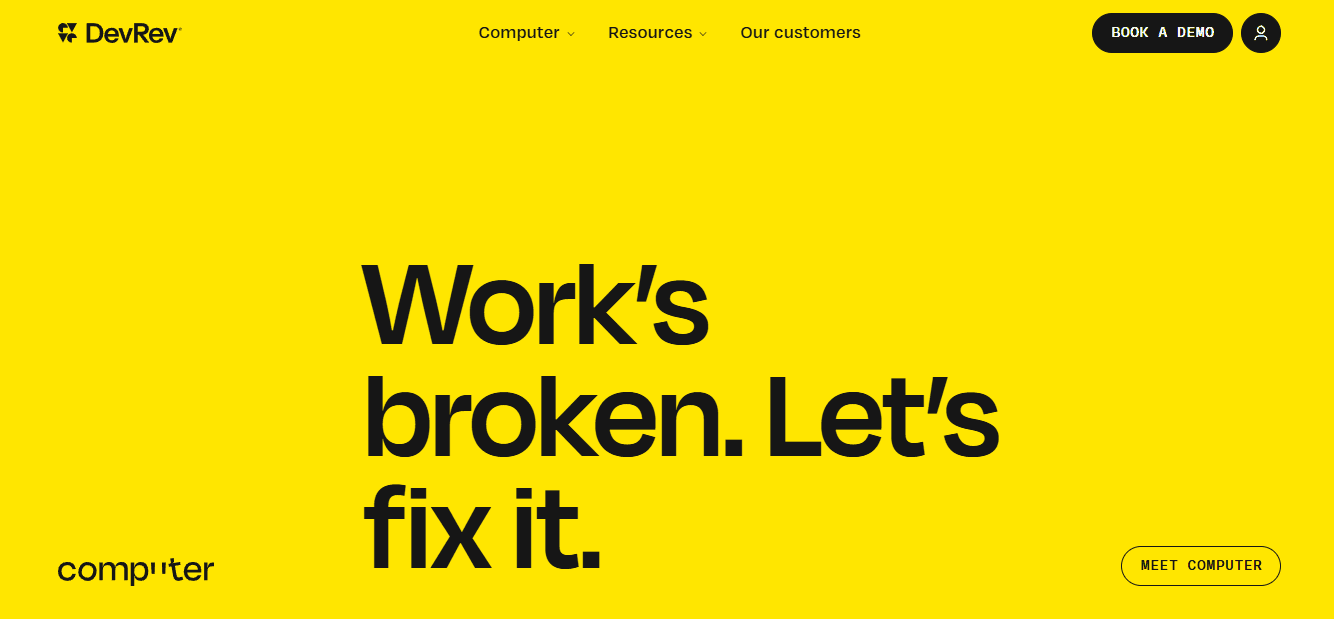
DevRev is an AI native platform that pairs generative chatbots with AgentOS to automate responses using knowledge graphs and large data pools. The system provides Support360 analytics to visualize metrics and session recordings to clarify customer context.Autonomous in-app agents personalize interactions and let teams set clear goals for journeys while reducing human load. How would support change if agents handled routine questions with accurate, context-rich answers?
Features
Generative chatbot: Answer customer queries using knowledge graphs for accuracy.
AgentOS automation: Create response workflows that draw from large data pools.
Support360 analytics: Visualize support metrics for better decisions.
Session recording: Review interactions to diagnose user issues precisely.
Autonomous in-app agents: Personalize engagement without manual scripting.
Knowledge-driven responses: Use structured data to improve reply quality.
28. Deeto: Turn Customers Into Advocates With Automated Advocacy
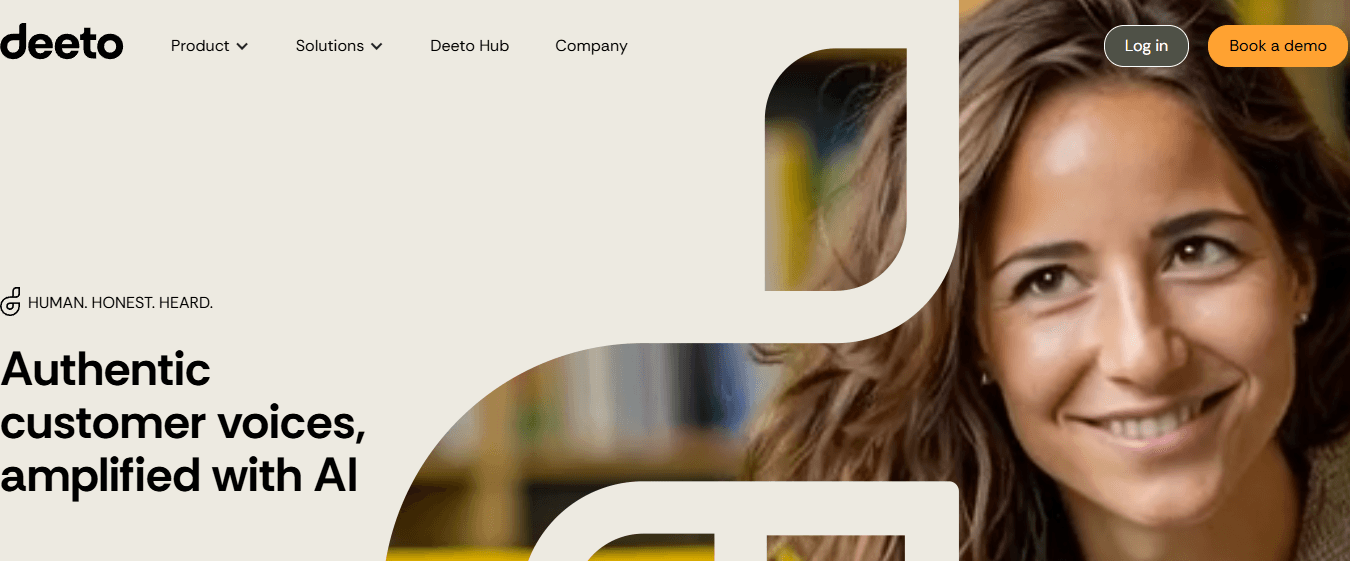
Deeto helps B2B companies convert satisfied customers into advocates by automating feedback collection, reference matching, and content creation. The platform streamlines everything from testimonials to reference calls, enabling sales and marketing to leverage customer success. AI features generate polished case studies and match advocates to prospects based on fit and use case. Would your pipeline improve if you automatically connected prospects with the most relevant customer stories?
Features
AI content generation: Turn feedback into case studies and testimonials automatically.
Smart advocate matching: Pair prospects with advocates by industry and use case.
Campaign automation: Send outreach and advocacy requests at the right moment.
CRM sync: Keep advocate and customer data aligned with Salesforce or HubSpot.
Real-time analytics: Track advocacy impact and sentiment trends.
Self-onboarding for advocates: Let customers choose how they contribute to your programs.
29. SurveySparrow: Conversational Surveys And Ticketing For CX Teams
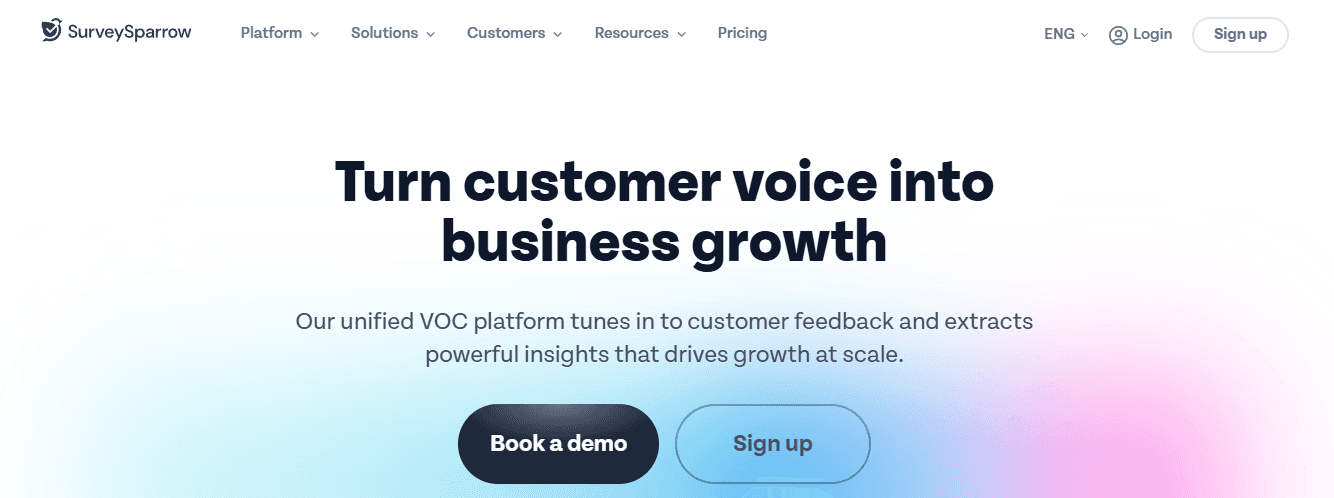
SurveySparrow combines conversational surveys with automated ticketing to surface NPS and CSAT insights while routing issues. The platform captures feedback and converts urgent responses into tickets for timely resolution. AI-driven sentiment and analytics help teams act on customer signals faster and with better context. What quick wins might appear if feedback flowed directly into your ticket system?
Features
Conversational surveys: Increase response rates with engaging survey formats.
Automated ticketing: Convert responses into actionable tickets for support teams.
NPS and CSAT tracking: Measure loyalty and satisfaction across touch points.
Sentiment analysis: Decode open text for emotion and priority.
Real-time dashboard: Monitor feedback trends and team performance.
Wide integrations: Connect with CRMs and collaboration tools to close the loop.
30. Front: Shared Inboxes That Make Teamwork Simple

Front centralizes email, chat, and SMS into a collaborative shared inbox that reduces duplicate replies and missed messages. The platform supports no-code automation to route messages and save repetitive effort across teams. Real-time collaboration and analytics provide visibility into team performance and response times, enabling managers to improve service levels. How many customer messages slip through the cracks today?
Features
Shared inboxes: Collaborate on customer messages without forwarding chains.
No code automation: Route and tag messages to streamline workflows.
Real-time collaboration: Draft and respond together with visibility.
Advanced analytics: Measure response time and team workload for improvement.
Multi-channel support: Handle email, chat, and SMS from one interface.
Extensive integrations: Connect to CRM, Slack, and productivity tools.
31. Tidio: AI Chat With Knowledge-Powered Responses Across Channels
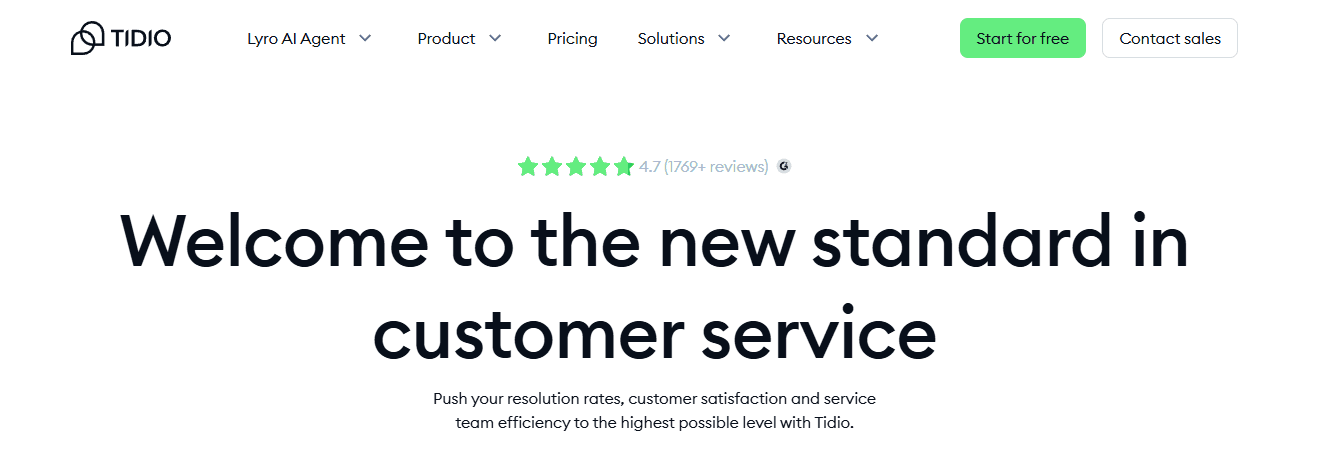
Tidio blends live chat, chatbot automation, and a help desk into a single platform where the Lyro AI Agent uses your support content to answer questions naturally. Flows let you design conversational paths that qualify leads, answer FAQs, and route complex issues to your team.A unified inbox consolidates messages from Messenger, Instagram, WhatsApp, and email, allowing agents to respond quickly and maintain consistent context across channels. What routine conversations could you delegate to AI so agents focus on high-impact work?
Features
Lyro AI Agent: Uses existing FAQs and docs to deliver human-like replies.
Flow builder: Design automated chat paths for lead capture and support.
Unified inbox: Manage messages from social, chat, and email in one place.
Help desk and ticketing: Track and prioritize issues until resolution.
eCommerce and CMS integrations: Connect with Shopify, WordPress, and others.
Multichannel automation: Provide consistent responses across platforms.
Related Reading
• AI Media Buying
• AI Sales Forecasting
• AI Agent Use Cases
• Automated Cold Calling
• AI Agent Implementation Business Benefits
• AI Agent vs Chatbot
• AI Marketing Agent
How to Choose the Right Customer Engagement Tool for Your Business

Match The Right Tool To Your Size, Goals, And Customer Engagement Needs
Start by accepting that the right AI customer engagement platform depends on:
Company size
Business goals
How your customers prefer to interact
Focus first on these core evaluation axes:
Integration capabilities
AI sophistication
Ease of use
Pricing and total cost
Analytics and reporting
Operational scalability
To avoid surprises, assess:
Existing workflows and data flows
Run small pilots
Involve:
Sales
Success
Support
Ask which outcomes matter most for your KPIs, then map features to those outcomes.
Operational Requirements for Seamless Escalation
For example:
If your priority is automated support, look for:
NLP chatbots
Intent detection
Multistep conversation flows
Seamless escalation to humans
If your priority is sales enablement, prioritize:
Predictive lead scoring
Conversation intelligence
CRM integration
Playbook automation
If you need omnichannel outreach, choose a platform with a:
Unified inbox
SMS and social support
Email sequencing
Web chat
Consider the long-term ROI and platform adaptability as models and regulations evolve, so you can swap components or export data if needs change.
Budget: What You Will Really Pay For AI Customer Engagement
List direct costs and indirect costs before you sign.
Direct costs include:
License or subscription fees
Usage fees for AI compute
Add-on modules for analytics or channels
Indirect costs include:
Integration work
Data migration
Customization
Staff training
Content creation for:
Knowledge bases
Model tuning
Ongoing maintenance
Projecting AI ROI: Balancing Compliance Costs with Operational Efficiency Gains
Factor in compliance and security expenses for data residency or encryption if you handle regulated data.
If you enable large-scale inference, build a three-year total cost of ownership model that includes expected:
Increases in conversations
Additional seats
Higher compute
Measure likely savings and gains against cost:
Reduced handle time
Higher conversion rates
Lower churn
Fewer hires are needed to cover volume
Define What Winning Engagement Looks Like For Your Team
What channels do your customers use now, and which will they use next year? Do you need proactive outreach or reactive handling?
Which KPIs will you measure for success:
First contact resolution
NPS
Conversion rate
Revenue per conversation
Average resolution time
Map the customer journey and mark where automation, personalization, and human handoffs must occur.
Note requirements such as:
Multilingual support
Compliance for regulated conversations
Offline message handling
Translate those needs into user stories and acceptance criteria, and prioritize features that move your most important metric.
Integration: How The Platform Must Fit Into Your Systems
Confirm CRM compatibility, event streams to your data warehouse or CDP, support for webhooks, and API contracts for real-time sync versus batch updates. Check single sign-on, role-based access control, and whether the vendor supports common CRM platforms out of the box or requires custom middleware.
Ask about a sandbox, data export options, and the ease of building connectors to:
Marketing automation
Billing
Fraud systems
Test the vendor API with a spike of realistic traffic and verify that message routing, contact merging, and customer identity resolution work against your production data model.
Scalability: Prepare For Growth And Traffic Spikes
Examine how the vendor scales model inference and message throughput. Do they autoscale model instances and queues to handle spikes? What are their rate limits and service level agreements for latency? Evaluate the tenancy model and data partitioning if you need strict access controls. Consider the operational cost of higher volume because model inference costs rise with concurrency and longer conversations. Plan capacity tests that mimic peak season traffic, multilingual load, and concurrent agent sessions to observe behavior before you commit.
Trials And Demos: Try Real Workflows, Not Canned Demos
Run a pilot that uses:
Honest conversations
Real customer segments
Real KPIs
Define a short list of success criteria and baseline metrics so you can measure lift.
If the integration causes issues, a good pilot includes:
Agent training
Live routing to fallback humans
Analytics tracking
An exit plan to revert
Use A/B testing or a control cohort to validate impact on:
Conversion
Response time
Satisfaction
Ask the vendor to expose logs and model confidence scores so you can audit behavior and tune models during the trial.
Match Needs To Tool Types With Quick Examples
Need automated self-service and fast ticket deflection?
Those who learns from transcripts choose platforms with:
NLP-powered chatbots
A strong knowledge base
Search
Intent classification
Focus on tools that support conversational analytics and sentiment analysis. Need to empower reps and close more deals?
For lead scoring, pick tools with:
Conversation intelligence
Guided selling
Real-time coaching
Playbooks
Sequence automation
Tight CRM sync
Need an omnichannel program for marketing and support? Prioritize unified messaging, event-based personalization, audience segmentation, and a CDP or customer data integration. Need compliance and data control for regulated customers?
Look for:
Single-tenant or private cloud deployment
Data residency guarantees
Audit logs
Model governance
Questions To Ask Vendors During Evaluation
Can you show a sandbox with my data or a realistic sample?
What are your export and data portability options?
How do you measure model drift, and who owns model updates?
What error handling and human escalation patterns do you support?
What are your SLAs for latency and uptime?
What hidden costs appear at scale like per-message inference fees or charges for new channels?
Checklist To Run Before Signing
Map end-to-end user flows and test them in a pilot. Get a clear pricing model for the scale you anticipate. Verify integrations with CRM and data warehouse.
Confirm:
Security
Compliance
Data export
Define success metrics and a rollback plan. Negotiate the trial length and a proof of concept scope that provides measurable signals about ROI and adaptability, enabling you to make a confident decision as the technology evolves.
Book a Free AI Strategy Call with our Team & Check Out our Free Training ($500k/mo in Less Than 2 years)
AI Acquisition helps professionals and business owners start and scale AI-driven businesses using existing AI tools and our proprietary ai-clients.com AI operating system.
We turn your skills and experience into revenue by:
Automating lead generation
Customer engagement
Service delivery with:
Conversational AI
CRM integration
Predictive analytics
You do not need a technical background, significant upfront capital, or to trade one job for another because the platform and our playbooks:
Handle setup
Onboarding
Operational automation
How does your current skill set map to an AI business model?
How the ai-clients.com AI Operating System Powers Customer Engagement
The ai-clients.com OS ties together chat automation, omnichannel messaging, segmentation, intent detection, and sentiment analysis into repeatable workflows.
It plugs into your:
CRM
Tracks behavior across:
Email
Chat
SMS
Scores leads
You can focus on the highest value prospects.
Automated sequences qualify leads with conversational flows, then:
Trigger personalized outreach
Upsell prompts
Support handoffs
You can optimize campaigns and retention with built-in analytics show:
Engagement metrics
Conversion rate
Average response time
Customer lifetime value
Why You Don’t Need a Tech Background or Big Capital
We use no-code tools, prebuilt templates, and prompt libraries so you skip complex architecture and expensive developers. Set up takes hours, not months. Hosting and AI compute are managed through the platform with transparent pricing, and you can start by offering services or packages that scale into productized offers.
The system automates:
Discovery calls
Qualification
Onboarding
Ongoing customer support
They can use these by virtual assistants and workflow automation, reducing labor and boosting margins. Want to see a sample setup using your existing tools?
How AI Automates the Customer Journey and Drives Sales
Map the customer journey, then create AI-powered touchpoints that move prospects through:
Awareness
Consideration
Purchase
Retention
Use chatbots to:
Capture intent and qualify leads
Personalize to improve conversion
Use predictive analytics to surface churn risk
Automate follow-ups for reengagement
Combine lead scoring with lifecycle marketing to increase conversion rate and average order value. Campaign reports show which messages drive engagement and which sequences raise retention so you can scale what works.
A Fast Growth Playbook You Can Use Right Now
For each interaction, pick a niche with:
Clear pain points
Map three core customer interactions
Implement AI workflows
Start with:
A lead capture bot
An automated qualification sequence
A billing or onboarding assistant
Measure:
Response time
Engagement rate
Deal velocity
To lift conversion, iterate:
On prompts
Segmentation
Timing
Then automate pricing experiments and referral campaigns to grow lifetime value and client acquisition without adding headcount.
My Path from Burnout to Building a Scalable AI Business
I left a demanding director role and applied the same systems we teach:
Niche selection
Productized services
AI-powered client engagement
I replaced manual outreach and repetitive delivery with:
Conversational AI
Automated onboarding
Analytics-driven optimization
Revenue scaled by focusing on high-value offers, improving conversion through personalized messaging, and automating follow-up, allowing the business to sell more while working less. That approach is what the free training demonstrates.
What You Learn in the Free Training
The free session walks through the whole system and shows live examples of chatbots, onboarding flows, CRM integrations, and revenue models you can copy. You get templates for lead generation scripts, conversational flows, and automated upsell sequences, plus a short checklist to set up your first buyer journey. The training includes real metrics and case studies so you can see how engagement automation turns prospects into clients.
What Happens on an AI Strategy Call with Our Consultants
On the call, we audit your skills, pinpoint a profitable niche, and map a 90-day plan with clear milestones. Consultants build a customer engagement blueprint that covers:
Conversational design
CRM mapping
Lead scoring
Deployment steps
You leave with a prioritized action list, revenue estimates, and the tech stack you need to launch quickly. If you want faster results, you can book a session to scope a done-for-you implementation.


